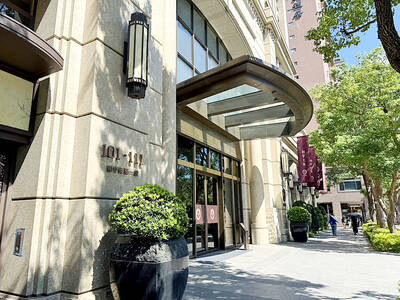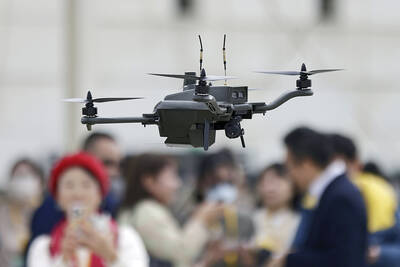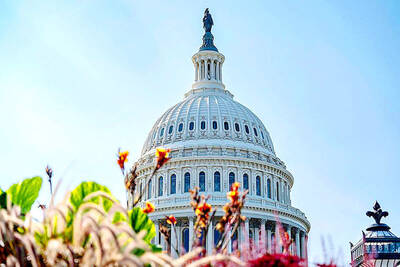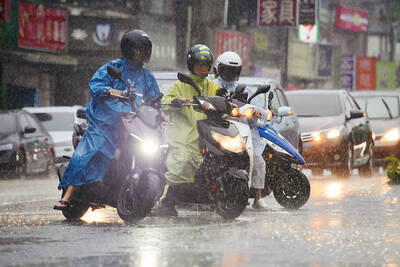The government yesterday welcomed international attention on Taiwan’s security, saying that China is to blame for threatening regional stability, after a report by The Economist called Taiwan “the most dangerous place on Earth.”
The report is featured on the cover of the magazine’s latest issue, which depicts the nation as the epicenter of a US-China rivalry.
The cover shows Taiwan in a radar display with dots crossing the Taiwan Strait accompanied by a Chinese flag and dots nearing the east coast with a US flag.
The US maintains a “one China” policy, while maintaining relations with Taiwan, but such “strategic ambiguity is breaking down,” as Washington fears it might no longer be able to deter China from attempting to seize Taiwan by force, the magazine said.
A cross-strait war would be a catastrophe, as Taiwan “lies at the heart of the semiconductor industry,” it said, adding that Taiwan Semiconductor Manufacturing Co (TSMC, 台積電), “the world’s most valuable chipmaker, etches 84 percent of the most advanced chips. Were production at TSMC to stop, so would the global electronics industry, at incalculable cost.”
The report said that “American and China must work harder to avoid war over the future of Taiwan,” as “nowhere presents such a test of statesmanship as the most dangerous place on Earth.”
Ministry of Foreign Affairs spokeswoman Joanne Ou (歐江安) said in a statement yesterday that many dignitaries, think tanks and media in the US, Australia, Europe and Japan have expressed concerns over the peace and stability of the Taiwan Strait under China’s political and military coercion.
The government is glad to see Taiwan’s existence, values and security recognized by the global community, Ou said.
The “danger” highlighted by the report originates from China, which not only targets the Taiwan Strait, but also directs intimidation and expansionism across the East China Sea, the South China Sea and South Asia, posing serious threats to regional security, she added.
Democratic Progressive Party spokeswoman Hsieh Pei-fen (謝佩芬) said the report demonstrates the threats posed by China that Taiwan deals with every day.
Many people used to consider it an issue between Taiwan and China, but now the international community has become aware of China’s threats to the world and regional stability, she said.
Chinese Nationalist Party (KMT) Chairman Johnny Chiang (江啟臣) urged leaders in Taipei, Beijing and Washington to stay rational and resolve conflicts through dialogue.
The Taiwan Strait should not become a battlefield for superpowers, which The Economist’s report echoes, Chiang said.
Taiwan would be wounded if a military and political face-off between the US and China grows, he added.
Additional reporting by CNA and Chien Hui-ju

FORCED LABOR: A US court listed three Taiwanese and nine firms based in Taiwan in its indictment, with eight of the companies registered at the same address Nine companies registered in Taiwan, as well as three Taiwanese, on Tuesday were named by the US Department of the Treasury’s Office of Foreign Assets Control (OFAC) as Specially Designated Nationals (SDNs) as a result of a US federal court indictment. The indictment unsealed at the federal court in Brooklyn, New York, said that Chen Zhi (陳志), a dual Cambodian-British national, is being indicted for fraud conspiracy, money laundering and overseeing Prince Holding Group’s forced-labor scam camps in Cambodia. At its peak, the company allegedly made US$30 million per day, court documents showed. The US government has seized Chen’s noncustodial wallet, which contains

SUPPLY CHAIN: Taiwan’s advantages in the drone industry include rapid production capacity that is independent of Chinese-made parts, the economic ministry said The Executive Yuan yesterday approved plans to invest NT$44.2 billion (US$1.44 billion) into domestic production of uncrewed aerial vehicles over the next six years, bringing Taiwan’s output value to more than NT$40 billion by 2030 and making the nation Asia’s democratic hub for the drone supply chain. The proposed budget has NT$33.8 billion in new allocations and NT$10.43 billion in existing funds, the Ministry of Economic Affairs said. Under the new development program, the public sector would purchase nearly 100,000 drones, of which 50,898 would be for civil and government use, while 48,750 would be for national defense, it said. The Ministry of

SENATE RECOMMENDATION: The National Defense Authorization Act encourages the US secretary of defense to invite Taiwan’s navy to participate in the exercises in Hawaii The US Senate on Thursday last week passed the National Defense Authorization Act (NDAA) for Fiscal Year 2026, which strongly encourages the US secretary of defense to invite Taiwan’s naval forces to participate in the Rim of the Pacific (RIMPAC) exercise, as well as allocating military aid of US$1 billion for Taiwan. The bill, which authorizes appropriations for the military activities of the US Department of Defense, military construction and other purposes, passed with 77 votes in support and 20 against. While the NDAA authorizes about US$925 billion of defense spending, the Central News Agency yesterday reported that an aide of US

The combined effect of the monsoon, the outer rim of Typhoon Fengshen and a low-pressure system is expected to bring significant rainfall this week to various parts of the nation, the Central Weather Administration (CWA) said. The heaviest rain is expected to occur today and tomorrow, with torrential rain expected in Keelung’s north coast, Yilan and the mountainous regions of Taipei and New Taipei City, the CWA said. Rivers could rise rapidly, and residents should stay away from riverbanks and avoid going to the mountains or engaging in water activities, it said. Scattered showers are expected today in central and